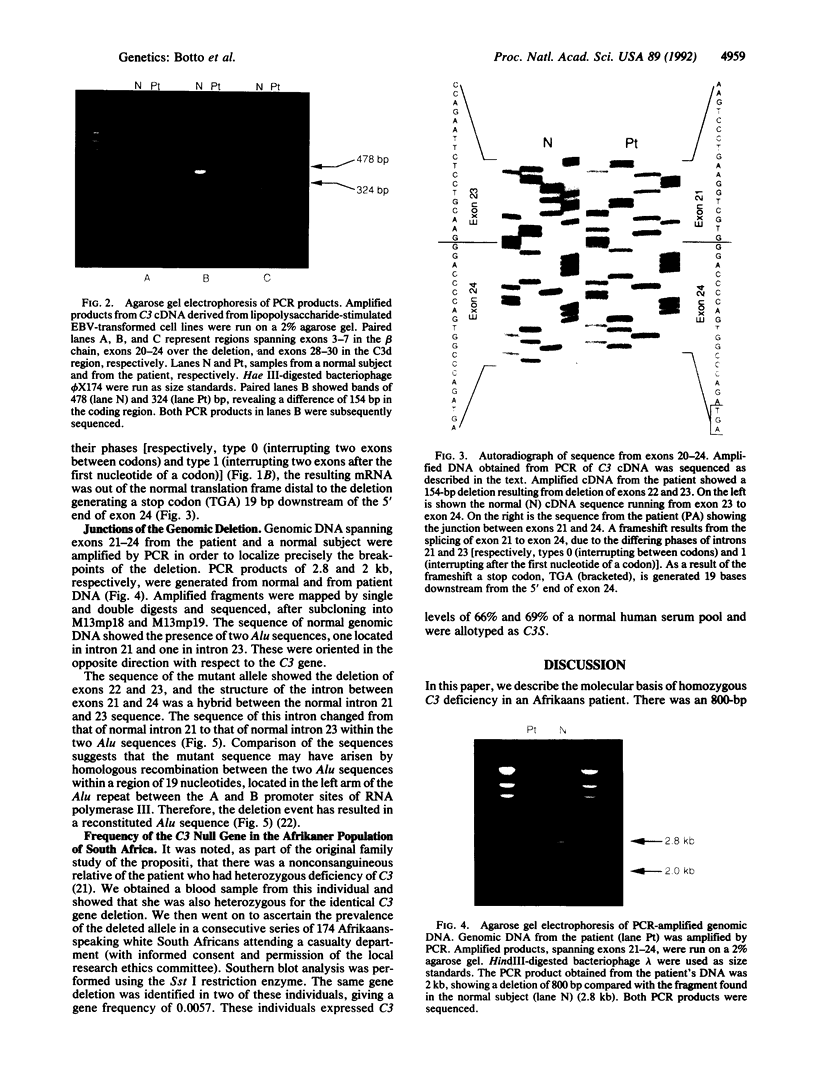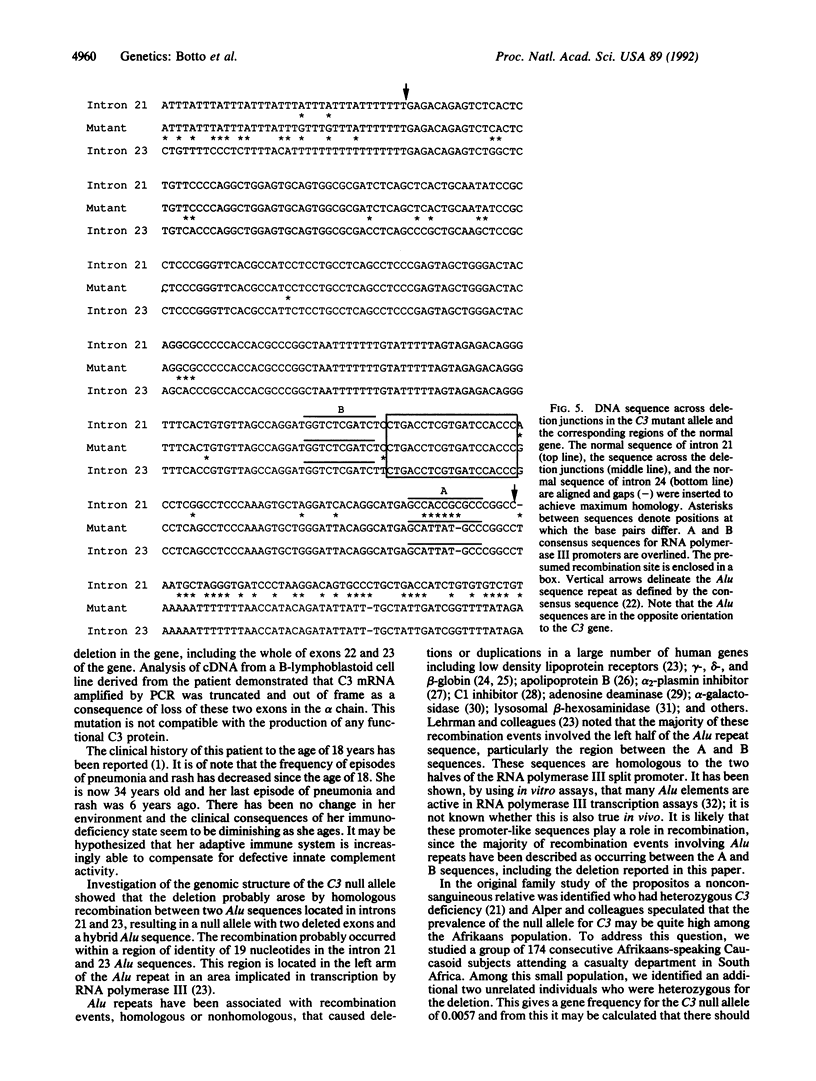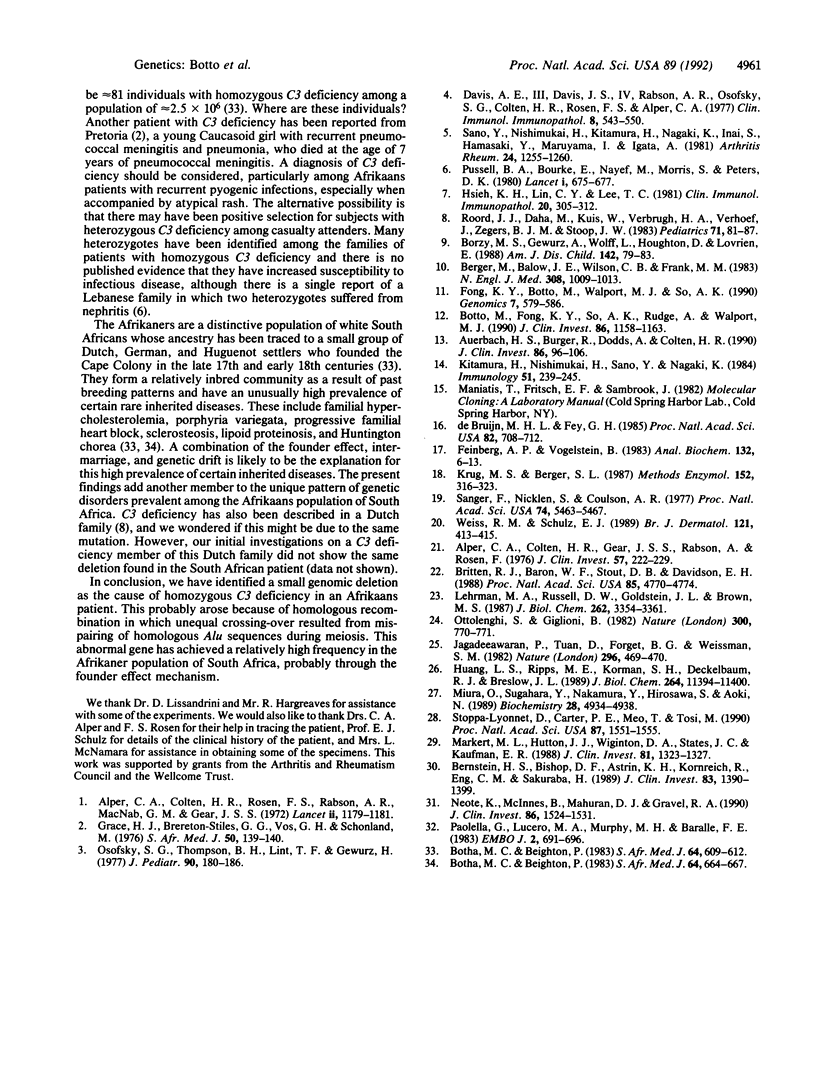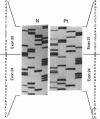Abstract
The molecular mechanism of C3 deficiency in an Afrikaans patient with recurrent pyogenic infections was studied. Restriction enzyme analysis showed a gene deletion of 800 base pairs (bp) mapping to the alpha chain of C3. Amplification of genomic DNA, using the PCR, demonstrated that the deletion included exons 22 and 23 of the C3 gene. Truncated mRNA was shown in an Epstein-Barr virus-transformed B-cell line by PCR amplification of first-strand cDNA. A consequence of this deletion was that the RNA transcribed 3' to the deletion was out of frame, resulting in formation of a stop codon 19 bp downstream from the deletion. The molecular basis of the deletion was compatible with homologous recombination between two Alu sequences located in introns 21 and 23. An unrelated nonconsanguineous relative and two of a sample of 174 Afrikaans-speaking individuals were heterozygous carriers of the same gene deletion. The wide prevalence of this null allele in this population is probably due to the effects of a small founder population. The presence of this deletion in the C3 gene is not compatible with production of any functional C3, supporting the idea that study of such patients offers a valid model for understanding physiological activities of C3 in vivo in humans.
Full text
PDF




Images in this article
Selected References
These references are in PubMed. This may not be the complete list of references from this article.
- Alper C. A., Colten H. R., Gear J. S., Rabson A. R., Rosen F. S. Homozygous human C3 deficiency. The role of C3 in antibody production, C-1s-induced vasopermeability, and cobra venom-induced passive hemolysis. J Clin Invest. 1976 Jan;57(1):222–229. doi: 10.1172/JCI108263. [DOI] [PMC free article] [PubMed] [Google Scholar]
- Alper C. A., Colten H. R., Rosen F. S., Rabson A. R., Macnab G. M., Gear J. S. Homozygous deficiency of C3 in a patient with repeated infections. Lancet. 1972 Dec 2;2(7788):1179–1181. doi: 10.1016/s0140-6736(72)92598-6. [DOI] [PubMed] [Google Scholar]
- Auerbach H. S., Burger R., Dodds A., Colten H. R. Molecular basis of complement C3 deficiency in guinea pigs. J Clin Invest. 1990 Jul;86(1):96–106. doi: 10.1172/JCI114721. [DOI] [PMC free article] [PubMed] [Google Scholar]
- Berger M., Balow J. E., Wilson C. B., Frank M. M. Circulating immune complexes and glomerulonephritis in a patient with congenital absence of the third component of complement. N Engl J Med. 1983 Apr 28;308(17):1009–1012. doi: 10.1056/NEJM198304283081706. [DOI] [PubMed] [Google Scholar]
- Bernstein H. S., Bishop D. F., Astrin K. H., Kornreich R., Eng C. M., Sakuraba H., Desnick R. J. Fabry disease: six gene rearrangements and an exonic point mutation in the alpha-galactosidase gene. J Clin Invest. 1989 Apr;83(4):1390–1399. doi: 10.1172/JCI114027. [DOI] [PMC free article] [PubMed] [Google Scholar]
- Borzy M. S., Gewurz A., Wolff L., Houghton D., Lovrien E. Inherited C3 deficiency with recurrent infections and glomerulonephritis. Am J Dis Child. 1988 Jan;142(1):79–83. doi: 10.1001/archpedi.1988.02150010089032. [DOI] [PubMed] [Google Scholar]
- Botha M. C., Beighton P. Inherited disorders in the Afrikaner population of southern Africa. Part I. Historical and demographic background, cardiovascular, neurological, metabolic and intestinal conditions. S Afr Med J. 1983 Oct 8;64(16):609–612. [PubMed] [Google Scholar]
- Botha M. C., Beighton P. Inherited disorders in the Afrikaner population of southern Africa. Part II. Skeletal, dermal and haematological conditions; the Afrikaners of Gamkaskloof; demographic considerations. S Afr Med J. 1983 Oct 15;64(17):664–667. [PubMed] [Google Scholar]
- Botto M., Fong K. Y., So A. K., Rudge A., Walport M. J. Molecular basis of hereditary C3 deficiency. J Clin Invest. 1990 Oct;86(4):1158–1163. doi: 10.1172/JCI114821. [DOI] [PMC free article] [PubMed] [Google Scholar]
- Britten R. J., Baron W. F., Stout D. B., Davidson E. H. Sources and evolution of human Alu repeated sequences. Proc Natl Acad Sci U S A. 1988 Jul;85(13):4770–4774. doi: 10.1073/pnas.85.13.4770. [DOI] [PMC free article] [PubMed] [Google Scholar]
- Davis A. E., 3rd, Davis J. S., 4th, Rabson A. R., Osofsky S. G., Colten H. R., Rosen F. S., Alper C. A. Homozygous C3 deficiency: detection of C3 by radioimmunoassay. Clin Immunol Immunopathol. 1977 Nov;8(3):543–550. doi: 10.1016/0090-1229(77)90019-8. [DOI] [PubMed] [Google Scholar]
- Feinberg A. P., Vogelstein B. A technique for radiolabeling DNA restriction endonuclease fragments to high specific activity. Anal Biochem. 1983 Jul 1;132(1):6–13. doi: 10.1016/0003-2697(83)90418-9. [DOI] [PubMed] [Google Scholar]
- Fong K. Y., Botto M., Walport M. J., So A. K. Genomic organization of human complement component C3. Genomics. 1990 Aug;7(4):579–586. doi: 10.1016/0888-7543(90)90202-6. [DOI] [PubMed] [Google Scholar]
- Grace H. J., Brereton-Stiles G. G., Vos G. H., Schonland M. A family with partial and total deficiency of complement C3. S Afr Med J. 1976 Jan 31;50(5):139–140. [PubMed] [Google Scholar]
- Hsieh K. H., Lin C. Y., Lee T. C. Complete absence of the third component of complement in a patient with repeated infections. Clin Immunol Immunopathol. 1981 Sep;20(3):305–312. doi: 10.1016/0090-1229(81)90140-9. [DOI] [PubMed] [Google Scholar]
- Huang L. S., Ripps M. E., Korman S. H., Deckelbaum R. J., Breslow J. L. Hypobetalipoproteinemia due to an apolipoprotein B gene exon 21 deletion derived by Alu-Alu recombination. J Biol Chem. 1989 Jul 5;264(19):11394–11400. [PubMed] [Google Scholar]
- Jagadeeswaran P., Tuan D., Forget B. G., Weissman S. M. A gene deletion ending at the midpoint of a repetitive DNA sequence in one form of hereditary persistence of fetal haemoglobin. Nature. 1982 Apr 1;296(5856):469–470. doi: 10.1038/296469a0. [DOI] [PubMed] [Google Scholar]
- Kitamura H., Nishimukai H., Sano Y., Nagaki K. Study on C3-like factor in the serum of a C3-deficient subject. Immunology. 1984 Feb;51(2):239–245. [PMC free article] [PubMed] [Google Scholar]
- Krug M. S., Berger S. L. First-strand cDNA synthesis primed with oligo(dT). Methods Enzymol. 1987;152:316–325. doi: 10.1016/0076-6879(87)52036-5. [DOI] [PubMed] [Google Scholar]
- Lehrman M. A., Russell D. W., Goldstein J. L., Brown M. S. Alu-Alu recombination deletes splice acceptor sites and produces secreted low density lipoprotein receptor in a subject with familial hypercholesterolemia. J Biol Chem. 1987 Mar 5;262(7):3354–3361. [PubMed] [Google Scholar]
- Markert M. L., Hutton J. J., Wiginton D. A., States J. C., Kaufman R. E. Adenosine deaminase (ADA) deficiency due to deletion of the ADA gene promoter and first exon by homologous recombination between two Alu elements. J Clin Invest. 1988 May;81(5):1323–1327. doi: 10.1172/JCI113458. [DOI] [PMC free article] [PubMed] [Google Scholar]
- Miura O., Sugahara Y., Nakamura Y., Hirosawa S., Aoki N. Restriction fragment length polymorphism caused by a deletion involving Alu sequences within the human alpha 2-plasmin inhibitor gene. Biochemistry. 1989 Jun 13;28(12):4934–4938. doi: 10.1021/bi00438a003. [DOI] [PubMed] [Google Scholar]
- Neote K., McInnes B., Mahuran D. J., Gravel R. A. Structure and distribution of an Alu-type deletion mutation in Sandhoff disease. J Clin Invest. 1990 Nov;86(5):1524–1531. doi: 10.1172/JCI114871. [DOI] [PMC free article] [PubMed] [Google Scholar]
- Osofsky S. G., Thompson B. H., Lint T. F., Gewurz H. Hereditary deficiency of the third component of complement in a child with fever, skin rash, and arthralgias: response to transfusion of whole blood. J Pediatr. 1977 Feb;90(2):180–186. doi: 10.1016/s0022-3476(77)80626-4. [DOI] [PubMed] [Google Scholar]
- Ottolenghi S., Giglioni B. The deletion in a type of delta 0-beta 0-thalassaemia begins in an inverted AluI repeat. Nature. 1982 Dec 23;300(5894):770–771. doi: 10.1038/300770a0. [DOI] [PubMed] [Google Scholar]
- Paolella G., Lucero M. A., Murphy M. H., Baralle F. E. The Alu family repeat promoter has a tRNA-like bipartite structure. EMBO J. 1983;2(5):691–696. doi: 10.1002/j.1460-2075.1983.tb01486.x. [DOI] [PMC free article] [PubMed] [Google Scholar]
- Pussell B. A., Bourke E., Nayef M., Morris S., Peters D. K. Complement deficiency and nephritis. A report of a family. Lancet. 1980 Mar 29;1(8170):675–677. [PubMed] [Google Scholar]
- Roord J. J., Daha M., Kuis W., Verbrugh H. A., Verhoef J., Zegers B. J., Stoop J. W. Inherited deficiency of the third component of complement associated with recurrent pyogenic infections, circulating immune complexes, and vasculitis in a Dutch family. Pediatrics. 1983 Jan;71(1):81–87. [PubMed] [Google Scholar]
- Sanger F., Nicklen S., Coulson A. R. DNA sequencing with chain-terminating inhibitors. Proc Natl Acad Sci U S A. 1977 Dec;74(12):5463–5467. doi: 10.1073/pnas.74.12.5463. [DOI] [PMC free article] [PubMed] [Google Scholar]
- Sano Y., Nishimukai H., Kitamura H., Nagaki K., Inai S., Hamasaki Y., Maruyama I., Igata A. Hereditary deficiency of the third component of complement in two sisters with systemic lupus erythematosus-like symptoms. Arthritis Rheum. 1981 Oct;24(10):1255–1260. doi: 10.1002/art.1780241005. [DOI] [PubMed] [Google Scholar]
- Stoppa-Lyonnet D., Carter P. E., Meo T., Tosi M. Clusters of intragenic Alu repeats predispose the human C1 inhibitor locus to deleterious rearrangements. Proc Natl Acad Sci U S A. 1990 Feb;87(4):1551–1555. doi: 10.1073/pnas.87.4.1551. [DOI] [PMC free article] [PubMed] [Google Scholar]
- Weiss R. M., Schulz E. J. Complement deficiency in Sweet's syndrome. Br J Dermatol. 1989 Sep;121(3):413–415. doi: 10.1111/j.1365-2133.1989.tb01441.x. [DOI] [PubMed] [Google Scholar]
- de Bruijn M. H., Fey G. H. Human complement component C3: cDNA coding sequence and derived primary structure. Proc Natl Acad Sci U S A. 1985 Feb;82(3):708–712. doi: 10.1073/pnas.82.3.708. [DOI] [PMC free article] [PubMed] [Google Scholar]






